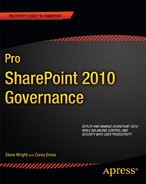Introduction to Application Management
Creating solutions for a SharePoint environment is similar in many respects to any other type of software development. It is important that you manage requirements, versions, and upgrades in a way that provides a predictable, repeatable process. This process is called Application Lifecycle Management (ALM) and is covered in more detail in Chapter 14. This chapter is devoted to exploring the types of components and modules you might typically create for a SharePoint application.
Any SharePoint solution can be broken down into two main categories of components: content and functionality. Content refers to the pages, lists, documents, and other items that are created by users and stored in SharePoint to be served to the visitors of the web site. Functionality refers to the logic that manages or processes that information. When customizing a SharePoint site it is sometimes difficult to distinguish between content and functionality.
Traditionally, end users create content and software developers and other IT staff create or deploy functionality. However, in the case of SharePoint, many items containing business process logic, such as workflows or InfoPath forms, can and should be created by business end-users instead of IT professionals.
Another way to distinguish content from logic would be to look at where they are stored. SharePoint stores its content as a series of content databases. Unfortunately, some items that must be managed as application components are stored in the content databases, so this is not ideal either.
For the purposes of SharePoint governance, we will define an application as a set of components that needs to be developed, deployed, and upgraded by a central development team. This may include user interface components, reusable content, software modules, workflow definitions, and so on. These components will be created, tested, and packaged by one group and deployed to the production farm for all to use.
Depending on the governance policies established for the site, it may also be acceptable for some of these types of components to be created by other groups within the organization. In that case, SharePoint contains controls that prevent independently-created applications from creating problems for the farm as a whole. These controls will be discussed later in this chapter and in the next.
